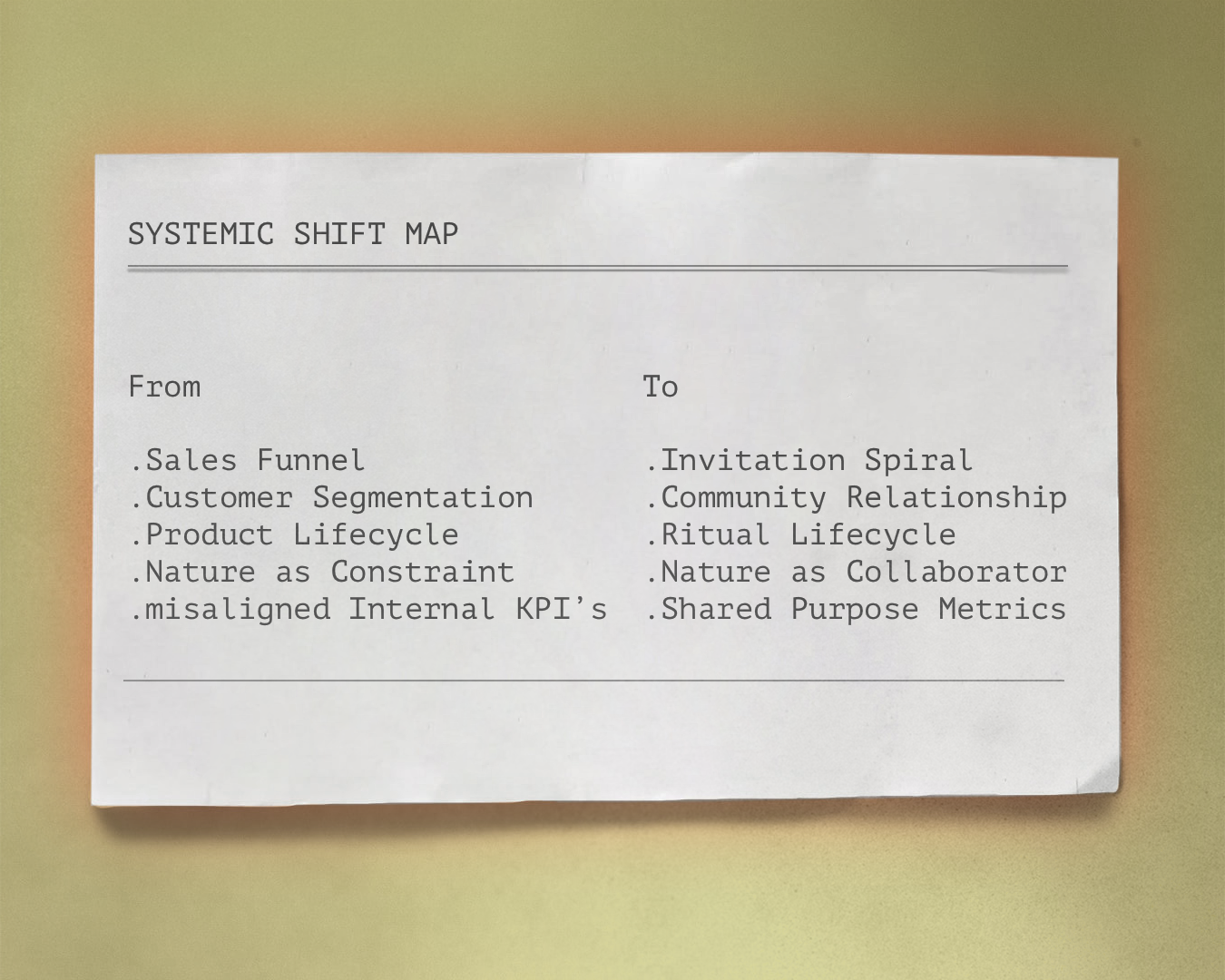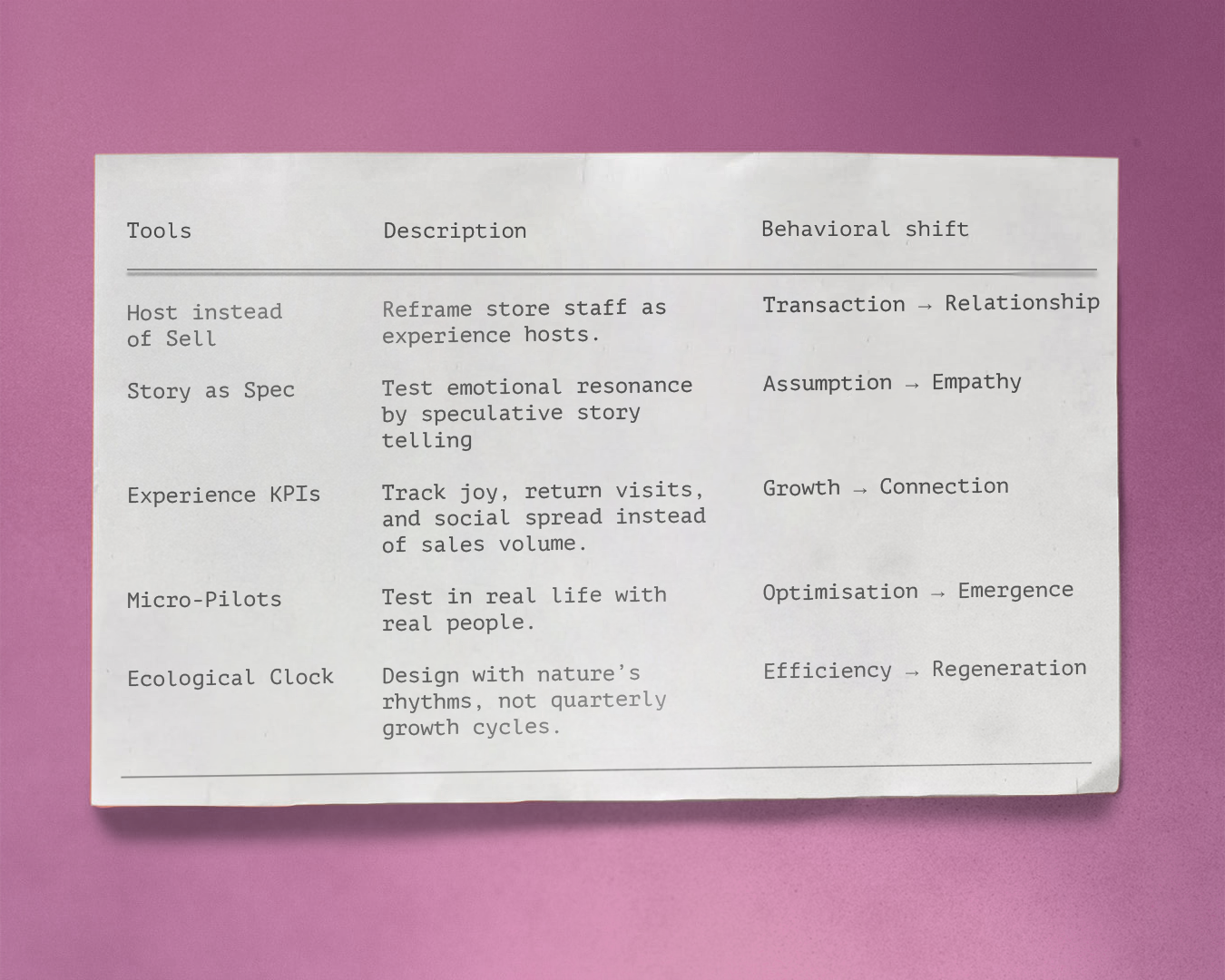A manual fragment for designing-with, not for.What lasting impression do we leave behind, even after our products are gone?
Extracted from:
Fieldnotes on a Live Experiment in Future-Resilient Practice — Experiences beyond productsAuthor:
Philipp OsterYear:
2025 for 2035Status:
In developmentClient:
Decathlon Sport ExperienceIntended use:
Internal transformation, public invitationMission
We partnered with Decathlon's sports experience team to define its 2035 vision for sports experiences.
Decathlon’s ambition as the third-largest sports brand worldwide is to reduce its ecological footprint according to the Paris agreement from 2021. Therefore, Decathlon is exploring different ways to reduce its dependence on actual product sales.
Sport experiences are set to become a major asset in this ambition.
Reasons to Act
Align the offer to changing user needs.
Enter new market segments.
1⁄3 product, 1⁄3 service, 1⁄3 experience
Meet and get ahead of stricter environmental regulations. (European Green Deal, etc.)
Act according to our ecological and societal responsibility.
“Performance is becoming less key; with increased social gathering leading to more sport practice…“
Strava report
Context
In 2035, environmental risks are dominating. Mis/Disinformation and AI proved to be of higher risk to societal well-being than espionage and warfare. Movement became a proxy for a broader systemic shift…
4 main trends can be identified:
Sport as counter movement
The myth of unifying global sports is fading, replaced by localised, participatory sport. The gladiatorial mega-events—Olympic Games, World Cups—still exist, but are increasingly controversial. Carbon footprints, sponsorship hypocrisy, and displaced communities lead to mass boycotts, and cities no longer want to host. Community games, resilience training, and outdoor survival are synonyms for joy, care and awareness—a way of living; now, here and in real life.
Sport as escape and medicine
Sport is widely accepted as a healing tool. Physical movement is prescribed not for performance but for emotional regulation and well-being. Mindful practices merge with sport: martial arts with meditation, running with ritual, dance with grief work.
The role of nature and exposure to the living world is recognised to have an overwhelming influence on people's mental and physical state.
Driven by technology
Sport is increasingly personalised and immersive, delivered through digital platforms. Enhanced by technologies like AR and VR, the lines between sports and e-sports are blurring. Technology is revolutionising athlete training, fan experiences, media consumption, and even the creation of new sports formats.
Sport as civic right, and infrastructure
Sport zones and playgrounds double as cooling zones in hyper-urbanised areas. Inspired by China, Europe has recognised public sport as a civic right, not a commodity, trying to lower long-term pressure on health and financial systems. Multigenerational, mixed-ability spaces foster resilience, not competition. Sport is reframed as a collective commons, a tool for social cohesion and recovery.
Design Hypothesis
Premise:
If we stop treating people as users and start recognising them as co-creators of meaning, then we can unlock regenerative loops of participation, community, and adaptive wellbeing.
Corollary:
If we remove performance pressure, profit-first thinking, and one-size-fits-all templates, then sport can reclaim it’s power as a social, cultural, and ecological act.
“Philipp has the courage and clarity to help us discover what we need to hear: unlocking new, more sustainable pathways forward.”
Etienne Gaillard
Senior Group Digital Product Manager | Sport Experience, Decathlon
A shift from extraction to relation.
From ownership to access.
From perfection to iteration.
Designing for what cannot be owned
What lasting impression do we leave behind, even after our products are gone?
This project didn’t deliver a product. It delivered a paradigm.
It isnʼt just the run, itʼs the shower, the views, and the evening drinks with my mates that make it special.ˮ
Customer statement
Sample narrative fragment
An ethnographic speculation—used to test the emotional logic of a new system.
“We were on our way back from the supermarket.
Saturday morning, bags full, heads down.
My daughter tugged my sleeve—she’d spotted music coming from the plaza near our tram stop.
There was a small basketball court set up, cones, skipping ropes, a few folding benches. A DJ playing low-key old-school hip-hop. Not a big event. Just a handful of kids running around, someone shouting encouragement, a few parents sipping coffee from thermos mugs.
One of the coaches walked over and asked if my daughter wanted to try.
She hesitated. Said she didn’t know how to play.
He said, “There is nothing you can do wrong. Let me show you.”
And she joined.
That was four weeks ago.
Now, every Saturday, she asks if we can swing by—“just to see if they’re there.”
Sometimes it’s basketball. Other times it’s skipping, running games, dance-offs with no winners.
It’s messy. And it works.
I signed up for updates with a QR code on a poster stuck to a lamppost. It led to a simple page—next week’s times, what to bring (water, old shoes, a hoodie if it rains).
Nothing flashy. But it felt made for us.
In the app, I found out they also offer indoor sessions at the community gym down the road.
We even got a message asking if we wanted to borrow some gear—trainers, skipping ropes, basketballs—to use at home during the week. My daughter thought it was magic.
What’s wild is, I’ve started joining in.
I haven’t moved like this in years. No mirrors. No goals. Just… play.
I met a few other parents. One of them’s a physiotherapist who offered to run a warm-up session.
Another's trying to set up a weekly walking group for people who “don’t run but still want to breathe.”
They asked if I wanted to host one too.
No pressure. Just pick a time, show up, invite others. They would help me set everything up.
A guy from the project said, “We don’t need instructors. We need neighbours.”
It’s strange. All this from a few cones and a speaker in a tired public square.
But it feels like something’s evolving. Like we’re learning how to move together again.”
Tools + Methods
Proposed interventions through our work.
Each, a gentle nudge beyond product-centric thinking.
Role and Approach
We partnered with Decathlon Sport Experience's internal team to explore the future potential of experiences.
The approach brought to the team was highly collaborative, to capture internal streams, movements and ideologies.
In mainly unstructured and explorative sessions, we captured what mattered most to funnel and reduce thoughts and ideas into a thought-provoking, inspiring vision document.
In parallel, we captured internal expertise and external insights by conducting stakeholder and customer interviews.
We didn’t aim to answer all questions, but to open conversations and discussions to inform a strategic decision-making process at the board level.
HOW TO USE THIS
This protocol isn’t finished because it never is.
It represents my current state of working. Please take it as an invitation to use and improve.
If you have any questions, please feel free to reach out.





